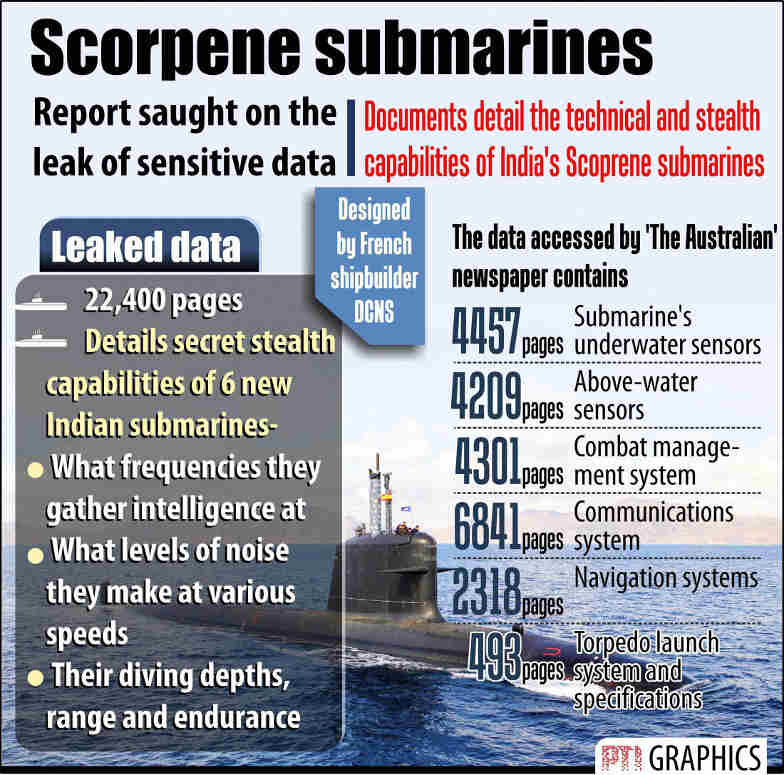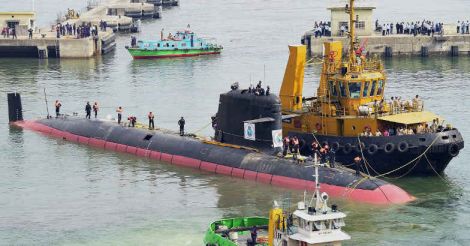The leak of sensitive data on Scorpene submarines, that are being developed in partnership with French firm DCNS at the state-run Mazagon Dock in Mumbai, has put the Indian Navy in a spot of bother with multiple concerns.
First and foremost, the naval authorities are yet to have a clear picture of the nature and extent of the information leak. According to reports, the leaked data contains over 20,000 pages outlining the details of six submarines under construction. However, The Australian, which published the documents relating to the submarine's combat capabilities, has so far released only a few sample documents.
Many of those leaked pages were marked ‘Restricted Scorpene India’. Under the process by which the government classifies information, the code ‘Restricted’ features at the bottom of the list of priorities.
In India, official documents are classified into five categories depending on their sensitivity. They are, Top Secret, Secret, Confidential, Restricted and Unclassified. The documents in the last category do not require security classification and can be published or communicated to any person. In short, they are not secret documents.
‘Restricted’ is applied to information meant only for official use, which is not to be published or communicated to any person except for official purposes. Based on their nature, importance, and implications, documents under the code ‘Restricted’ are placed just above the ‘Unclassified’ category. Often, even the press releases issued by the country’s armed forces are marked ‘Restricted’. That means such documents contain information meant only for the official use of journalists.
Even the telephone directories at military offices bear the code ‘Restricted’. It can be accessed by clerks and lower grade servants, but the information cannot be passed on to general public indiscreetly. The data that have been put up by the Australian newspaper on its website fall under this category.

The category ‘Confidential’ figures just above ‘Restricted’ on the sacrosanct list. The information under this category is meant only for official use by the military authorities concerned.
The next category ‘Secret’ is for information that are being compiled and made accessible to only to the officials of a particular branch of the military.
The files classified as ‘Top Secret’ do not travel below the head of each branch of the armed forces, explains Lt. Gen. Philip Campose, former vice chief of army staff of the Indian Army.
To be precise, the ‘Secret’ and the ‘Top Secret’ categories are reserved for the most sacred secrets pertaining to national security. The leaked data, however, do not carry such information, says commodore (retd) C. Uday Bhaskar, former director of the National Maritime Foundation.
“However, we cannot be hundred percent sure that all the secret files on Scorpene Submarines are safe. The media could not have gained access to some portion of the leaked data. It is a possibility, but we have to wait till the completion of the Indian Navy’s probe into the matter,” he said.
Another possibility is that the leaked information contains only technical specifications of the deal forged with the French naval contractor to develop the submarines. They could be the documents that were prepared ahead of inking the $3.5-billion contract with the French DCNS or the ‘Request for Proposal’ (RFP) documents sent to shipbuilders from across the globe at the tendering stage.
Leaked Scorpene papers won't affect stealth aspect: Indian Navy
It is these assumptions and speculations that pose the biggest headache to the Indian Navy. They know that secret information in huge quantities have been leaked, but they are struggling to determine the extent of damage caused by the reported leak. A detailed investigation is required to ascertain how and from where the leak occurred.
The Navy, downplaying the impact of the incident, implied that the leak might have occurred from France’s end and Indians had no role in it.
The leakage will definitely become a serious issue if the leaked data contained details of the combat and stealth capabilities of the Scorpene submarines. Immediate cancellation of the contract is not a viable option as the work on developing the submarines are nearing competition and are expected to be inducted in the Indian Navy soon.
The Indian Navy currently operates a fleet of 12 submarines; most of the which are Russian-built Kilo-class procured in the 80s and 90s. Many of these worn-out vessels constantly undergo repairs and refits at the Naval Ship Repair Yard. As a result, the Navy currently has six or seven submarines that are ready for emergency operations.
All you need to know about India's Scorpene submarine
As far as the Indian security forces are concerned, one of the secret weapons of great powers is their submarine fleet. The design, size and noise levels produced by the submarines and the details of their underwater sensors are best kept secrets. All such high-tech combat vessels have some level of magnetic signature, and a country’s strategic rivals will try hard to uncover the strengths and weaknesses of its submarine forces.
For instance, during the bilateral naval exercise between the US Navy and Indian Navy in early 90s, the former expressed keenness in conducting a drill featuring India’s Kilo-class submarines. Realizing the potential threat of such an exercise to their maritime strategies, Iran, which owned similar submarines, requested India to reject America’s proposal. Russia too demanded India to pay heed to Iran’s request.
There was a hidden agenda behind the American move. Americans were not able to measure the Iranian submarines’ distinct underwater signatures even with the powerful sensors they installed along the narrow Bosphorus to the Persian Gulf. Iran feared that Americans would target their vessels if they succeeded in making out the their distinctive underwater and acoustic signatures by operating in close proximity with similar submarines.
Conceding the requests made by Iran and Russia, India informed the US navy that its Kilo-class submarines would not be made available for the exercise, forcing America to drop their secret plan. The entire episode, however, did not draw much media attention then.
The latest incident poses a grave threat to India’s national security. If the leaked data contained details of Scorpene’s unique underwater signature and the planned weapon system, the country will be left with no other option than re-engineering them from scratch. It is indeed a time-consuming exercise.
(R. Prasannan is an expert in defence and foreign affairs)

























 Scorpene submarine
Scorpene submarine